A mother uses CBD to treat her son's seizures. A veteran hopes it will help her wean off opioids. A dietitian says it helps her sleep through the night. Even a pet owner uses it to calm his anxious Saint Bernard. These are just some of the estimated 64 million Americans who have tried CBD, or cannabidiol, in the past 24 months, according to a January 2019 nationally representative Consumer Reports survey of more than 4,000 Americans.
The survey found that more than a quarter of people in the U.S. say they've tried CBD—a compound in marijuana and hemp that doesn't get you "high"—for a slew of mental and physical reasons. One out of 7 of those people said they use it every day.
Americans of all ages are using it, too. It's most popular among people in their 20s, with 40 percent of them saying they have tried CBD. But so have 15 percent of people 60 and older. And our survey respondents also said it helped. Most of those who tried CBD reported that it was effective, especially among those who used it for anxiety. In some cases, they said CBD allowed them to eliminate over-the-counter or prescription drugs, including opioids.
Sold in pill form, oils, tinctures, topical lotions, and even in bottled water, coffee, beer, and cosmetics, CBD is already in hundreds of products on the market. And that could soon rise sharply, in part because of recent changes in federal law that allow U.S. farmers to legally grow hemp, according to the Brightfield Group, a market research firm specializing in cannabis. The company expects the CBD market from hemp alone to grow to $22 billion by 2022, up from $327 million in 2017. (Watch our video below on the emergence of CBD.)
At the same time, more states are legalizing marijuana itself for medical use and, increasingly, for adult recreational use. More than a quarter of Americans now live in the 10 states, plus Washington, D.C., where recreational use is legal, including California, Colorado, and Massachusetts. And others, including New Jersey and New York, could be joining the list soon.
More than three-quarters of U.S. adults favor legalizing the medical use of marijuana, according to a separate nationally representative 2018 CR survey of more than 1,000 U.S. adults, and half support legalizing recreational use.
While more Americans may be using CBD and marijuana, the laws and regulations governing both remain confusing and inconsistent.
For example, although marijuana is now legal to one extent or another in 33 states, it remains illegal federally. And despite the loosening of rules governing the growing of hemp, some cities and states have recently cracked down on food that contains CBD, calling it an unapproved food additive.
Meanwhile, some scientists, doctors, and public health officials question what's really known about the benefits—and risks—of CBD by itself, and of marijuana, too. In fact, the growing interest in marijuana has renewed concerns about its safety, ranging from impaired driving to mental health problems.
If you decide to try cannabis, here's what to know about its potential health benefits and risks, as well as how to stay safe and avoid potentially dangerous products.
CBD
Until recently, CBD was an underappreciated compound in cannabis. Growers actually tried to breed it out of plants, seeking strains with higher THC levels, according to Martin Lee, a cannabis historian. It wasn't until 2009, he says, that growers came across plants containing large amounts of CBD.
Some research suggests that CBD may affect the "endocannabinoid system," a series of receptors found throughout the body that seem to interact with various compounds in cannabis, including CBD, and some of which are related to feelings of anxiety and pain, or that help regulate the body's sleep-wake cycles.
CBD's most far-reaching health effect may be its anti-inflammatory properties. And not just in a knee or hip joint, but throughout the body, including the central nervous system and the brain, says Joseph Maroon, M.D., a clinical professor of neurological surgery at the University of Pittsburgh Medical Center, who has investigated the link. In a 2018 review, he and colleagues said such effects could possibly reduce anxiety, depression, seizures, and post-traumatic stress disorder (PTSD), and even benefit people who have had a concussion.
The best studies of CBD so far have been in the area of seizures, and the results were strong enough that last year the Food and Drug Administration approved a prescription version of CBD, called Epidiolex.
CR's survey also provides some support for CBD's possible health benefits. Almost three-quarters of people who took CBD said it was at least moderately effective for the main reason they took it, with 48 percent of them saying it was very or extremely effective.
And CBD seemed to work well for some of the most common problems, including easing stress and joint pain, and improving sleep. Our survey also suggests that side effects are uncommon; almost three-quarters said they experienced no side effects.
Also promising: 22 percent of people who took CBD for one of the health problems we asked about said it helped them replace prescription or OTC drugs, with more than a third of them saying they used it to replace opioids. And some researchers across the U.S. are now studying whether CBD (alone or in combination with THC) could be a tool in the fight against the ongoing opioid crisis.
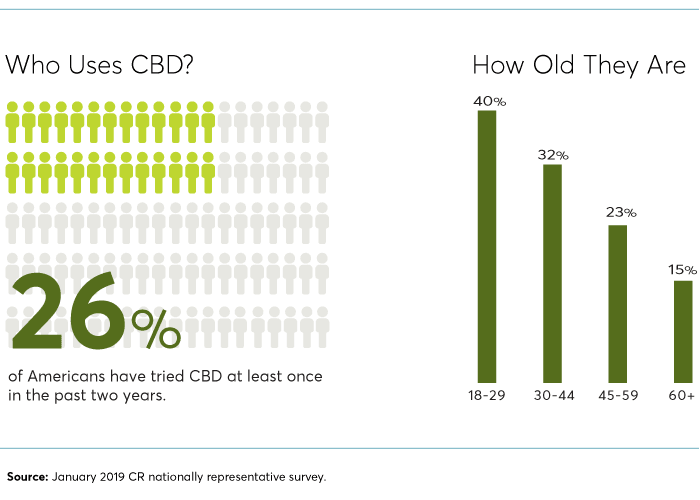

Where and How CBD Is Sold
You might find CBD online or in local health-food stores or CBD-specific retailers. In CR's survey, edibles including gummies and other infused foods and drinks were the most popular way to get CBD, with oils or drops, vape pens, and rubs also common.
Look for products that show how much CBD is in each dose, not just the whole product, says Mitch Earleywine, Ph.D., a professor of psychology at the University at Albany, State University of New York, who has studied the medicinal use of CBD.
Dosages, which are expressed in milligrams, or mg, vary depending on the form of the product, and experts often suggest starting with products that have relatively low doses. For example, with tinctures, Earleywine suggests generally starting with a product that has just 10 mg per dose.
Avoid products that make sweeping health claims, because they're often inaccurate and illegal.
If you vape, know that the concentrated oils used can contain a solvent called propylene glycol. When burned at high temperatures, it can degrade into formaldehyde, which can irritate the nose and eyes and could increase the risk of asthma and cancer. So consider CBD vape pens that advertise "solvent-free oils."
To date, few states require testing of CBD products sold online or in retail stores. The best way to find out whether a product has what is claimed is to ask for its COA, or certificate of analysis.
That document shows how a product performed on tests, typically commissioned by the manufacturer, checking for CBD and THC levels, and whether it contains contaminants like heavy metals or pesticides. If an online manufacturer or a retail store doesn't have the information or refuses to share it, look for another product.
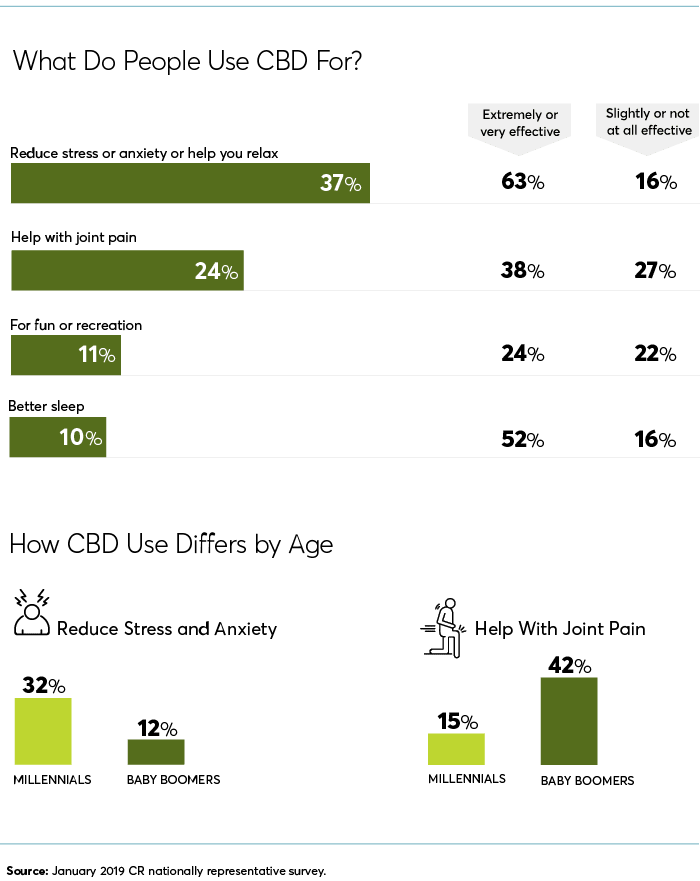
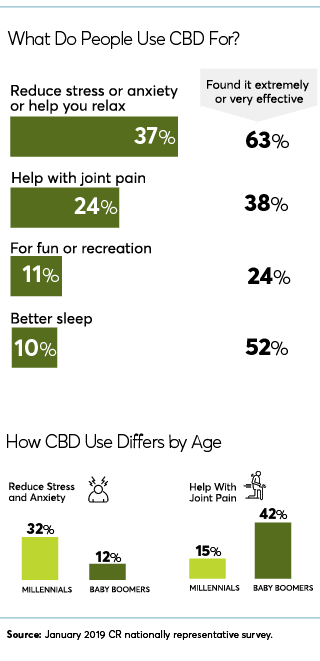
CBD's Legal Status
The legal status of CBD is still somewhat murky. Forty-seven states have passed laws legalizing it to one extent or another. (If it comes from hemp, THC levels must stay very low—0.3 percent or below compared with the 20 percent or higher concentrations typical in marijuana.) And the 2018 Farm Bill allows farmers to grow hemp and legalizes hemp derivatives like CBD. The bill also removes CBD extracted from hemp from the Drug Enforcement Administration's list of Schedule I drugs such as heroin, which the DEA deems to lack any medical use and to pose a high risk of abuse. (Marijuana and THC remain Schedule I drugs.)
But on the federal level, the FDA still has reservations. That's partly because now that the agency has approved a CBD-based prescription drug—Epidiolex—it says any product that markets the compound for health purposes should go through the FDA's rigorous official drug approval process.
In addition, the FDA notes that when CBD is put into food—say, a cookie, honey, coffee, or water—it is considered a "food additive." And the agency has not yet approved CBD for that purpose.
As a result, some local health officials have started to crack down on CBD in food. Michael Lanza, a spokesman for New York City's Department of Health and Mental Hygiene, says the city prohibited CBD in food after being advised by the FDA that it was "unlawful to add [CBD] to food and drink." Regulators in Maine, Ohio, and elsewhere have taken similar steps.
The FDA has said that it will hold a public hearing "in the near future" on how to regulate CBD and clarify confusion over CBD's legal and regulatory status.
In the meantime, we have found only a handful of reported examples of people who faced legal troubles for possessing CBD. Charges in at least one of the cases, in Texas, were ultimately dropped.
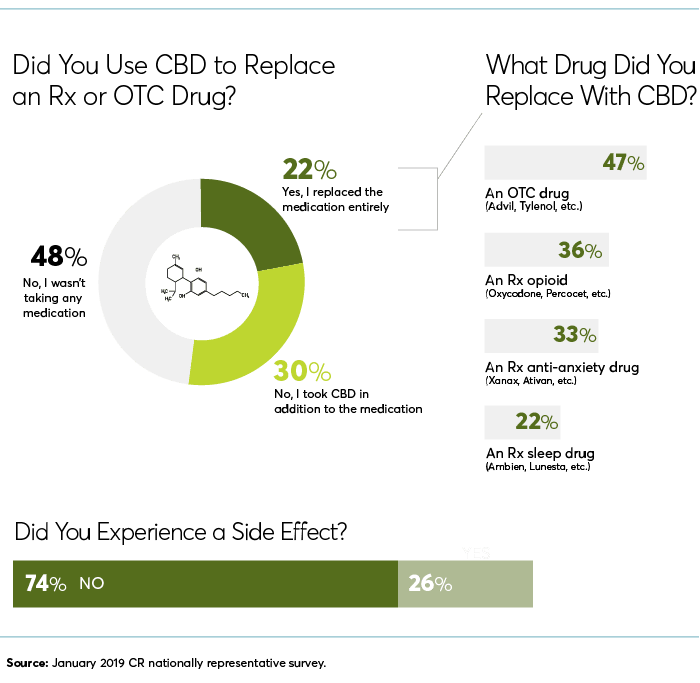

Marijuana
Used for thousands of years in religious ceremonies and as a social elixir, marijuana also has dozens of recorded medical uses. Pioneer women in the U.S. used it to ease nausea during pregnancy and to hasten childbirth, and by the mid-1800s early drug companies were marketing cannabis-based tinctures. Today, 33 states plus Washington, D.C., allow marijuana for a variety of medical purposes. But how effective is it, really?
A seminal 2017 report by the National Academy of Sciences that reviewed hundreds of marijuana studies found strong evidence for it in chronic pain, nausea and vomiting from chemotherapy, and muscle spasms in those with multiple sclerosis (MS). And it found moderate evidence for sleep problems (particularly sleep apnea) as well as pain from fibromyalgia and MS.
But marijuana clearly poses risks, too. Immediate ones include impaired mental and physical performance—which may be why its use is linked to car crashes. An October 2018 study found that in four states with legal recreational marijuana—Colorado, Oregon, Nevada, and Washington—crashes were up 6 percent compared with four neighboring states where recreational use was restricted.
And when taken in high doses, marijuana can cause hallucinations, delusion, and psychosis, according to the National Institute of Drug Abuse (NIDA). Long-term heavy use may even be associated with an increased risk of schizophrenia, though that could be because people with schizophrenia may be more likely to use marijuana.
Longer-term use, especially when started young, poses a risk of addiction, according to NIDA, and may impair brain development. Smoking marijuana can also lead to lung infections and coughing, though even frequent use isn't clearly linked to lung cancer.
One less familiar risk of heavy, chronic marijuana smoking can be severe, repeated nausea and vomiting, which can lead to emergency room visits.
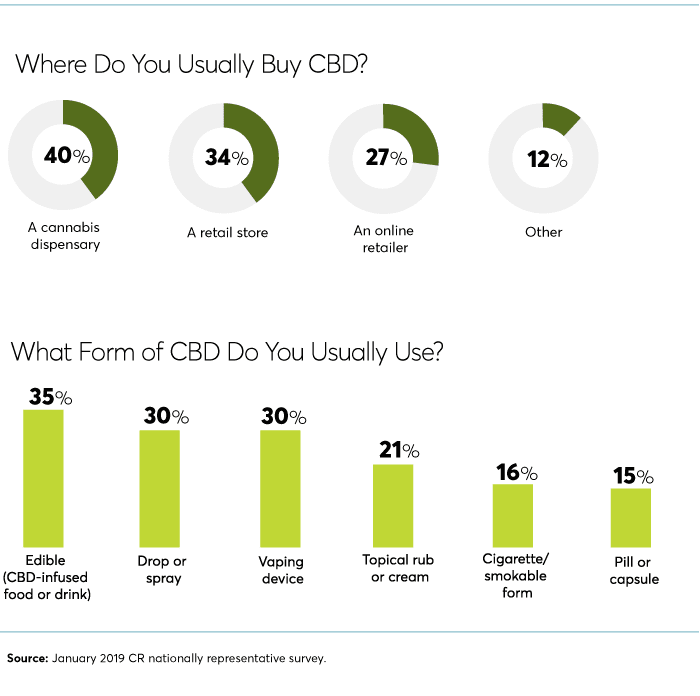

Where and How Marijuana Is Sold
In any dispensary, bring cash: Banking is federally regulated, so few accept even credit cards. Once inside, it's often like a jewelry store, with products under glass displays. So you'll need to talk with a salesperson.
Although you can buy marijuana "flower" either in loose form or as pre-rolled cigarettes, many smokers vape cannabis using concentrated oil cartridges (similar to e-cigarettes). Look for "solvent-free" oils.
Increasingly, THC, CBD, and other cannabis compounds are also being infused into oils or tinctures as well as teas, cookies, brownies, and other edibles. But it can be easy to get dangerously high doses of THC through edibles because they can be consumed quickly, so their use requires extra caution.
Marijuana is also sold as creams, time-release patches, and even suppositories. Such topicals are more likely to have localized effects—like helping to ease a sore knee—and less likely to cause a "head high."
Staff sometimes put products into a childproof bag or pouch, though extra steps should be taken at home to keep them out of the reach of children.
You can also purchase products in dispensaries that contain CBD extracted from marijuana. They may have more THC than would be allowed in those sold online or in retail stores but may also be more likely to contain what is claimed, and to be free of contaminants. That's because states typically require more testing of products sold in dispensaries.
Marijuana's Legal Status
The distinction between state and federal law may matter most in places where the federal government has jurisdiction, such as national parks, even in states where recreational use is legal. That's also true for airports. Even if you're flying between two states that have legalized recreational use—say, California and Colorado—it's still illegal to fly with marijuana, according to the Transportation Security Administration.
Local jurisdictions typically don't allow people to use marijuana in public or while driving. But Denver now permits its use in certain registered businesses.

There are currently only four cannabis-based medications approved by the Food and Drug Administration that your doctor can prescribe for you and that you can pick up in a pharmacy like any other prescription drug.
That includes Epidiolex, a drug approved in 2018 by the FDA to treat two rare but devastating forms of epilepsy. Epidiolex contains CBD extracted from marijuana plants as the active ingredient.
The other three drugs—Cesamet, Marinol, and Syndros—have a synthetic form of THC and are used to treat nausea stemming from cancer treatment or, in some cases, weight loss in AIDS/HIV patients.
To get FDA approval for those medications, drugmakers were required to conduct multiple clinical trials showing the safety, effectiveness, and proper dosing for each of those drugs. Such drugs can be expensive.—Epidiolex could cost $2,700 a month, for example.
Podcast: Understanding CBD
Editor's Note: This article also appeared in the May 2019 issue of Consumer Reports magazine.















